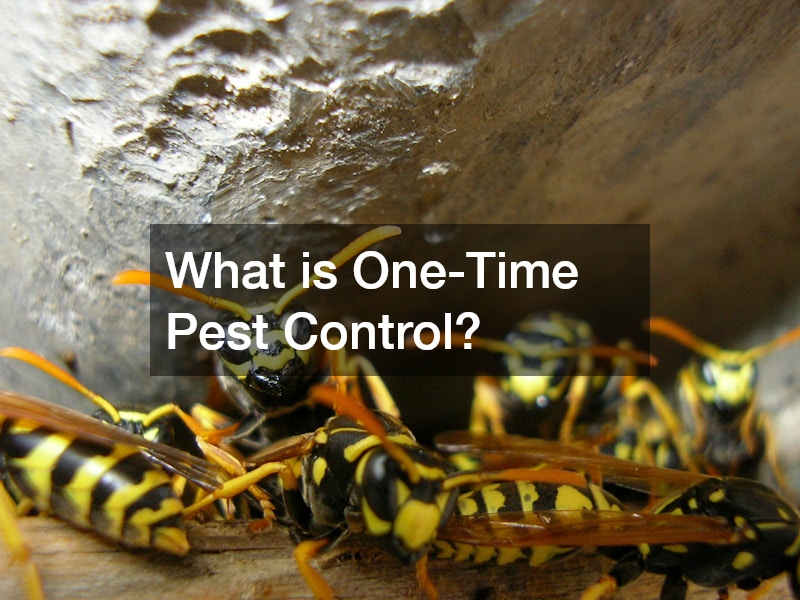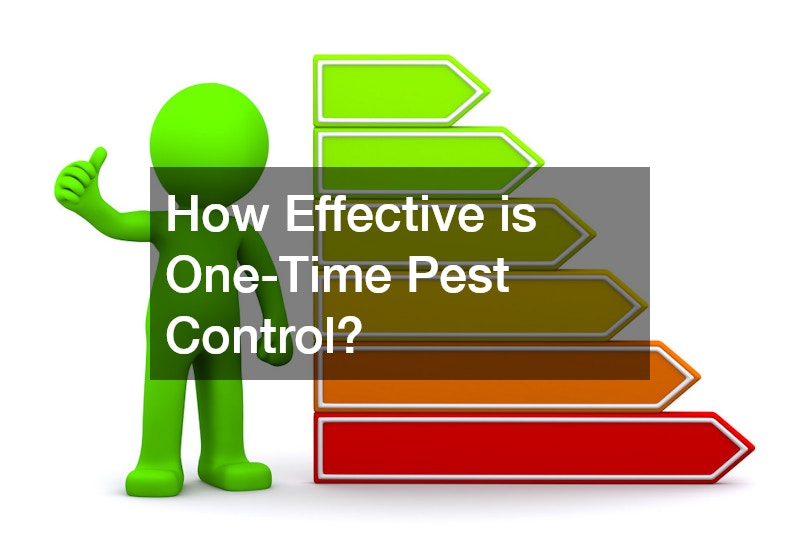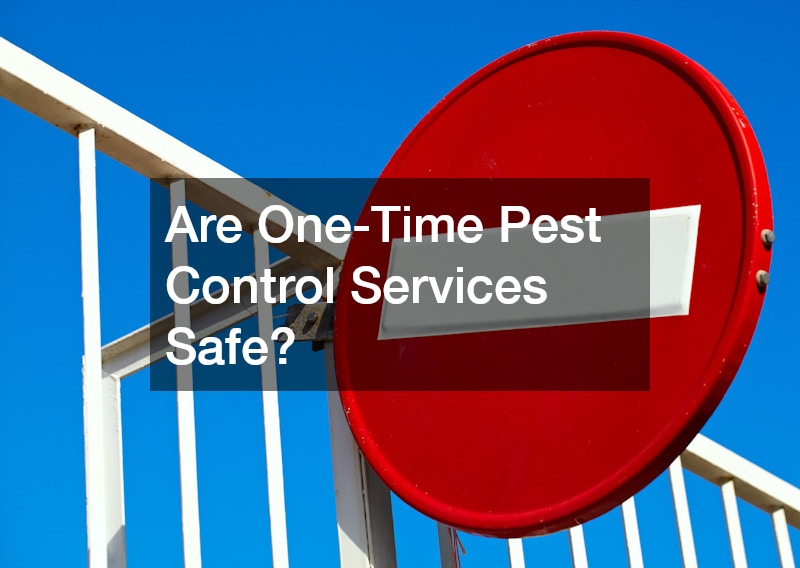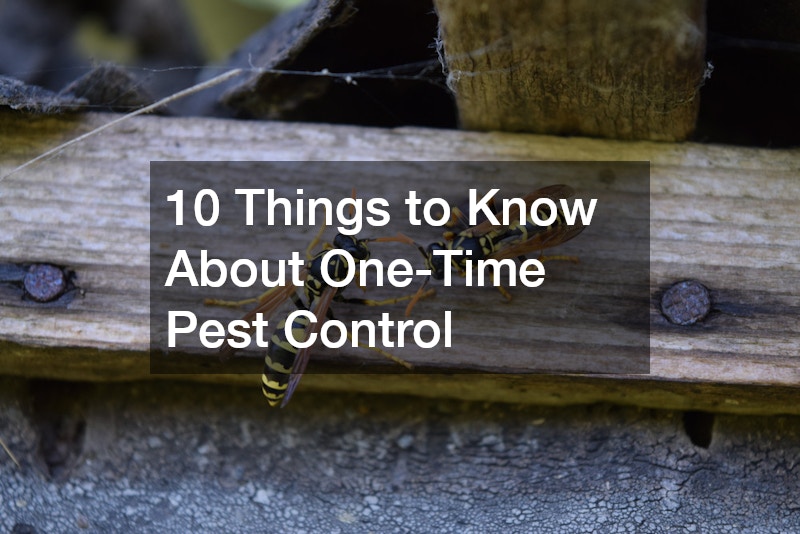Understanding one-time pest control is crucial for homeowners and businesses aiming to address pest problems effectively without committing to ongoing treatments. This approach provides a targeted solution for immediate infestations, making it an appealing choice for those who require fast, efficient results. However, many people have questions about its effectiveness, cost, and suitability for different types of pests and environments. By addressing these concerns, individuals can make informed decisions that align with their needs and circumstances. This guide delves into the most common questions surrounding one-time pest control services, offering practical insights and expert advice to help you navigate this pest management option with confidence.
1. What is One-Time Pest Control?

One-time pest control refers to a single, comprehensive treatment designed to address a specific pest issue. Unlike regular pest control services, which involve scheduled maintenance visits, one-time pest control focuses on immediate and acute infestations. It is an attractive option for people dealing with sudden outbreaks of pests or those who want a quick solution without long-term commitments.
This type of pest control is ideal for both residential and commercial properties. It allows homeowners, landlords, and businesses to address pest problems efficiently without affecting daily operations dramatically. Whether you’re a homeowner noticing unwelcome insects inside your home or a business facing a pest issue that could affect customer perception, one-time pest control might be the ideal solution.
The service typically includes an inspection to identify the type and extent of the infestation, followed by targeted treatment using appropriate pesticides or methods. The aim is to eliminate the pests present while minimizing harm to the environment and ensuring safety for occupants. Professional pest control companies offer this service, ensuring effective and professional handling of pest problems.
2. How Does One Time Pest Control Differ from Regular Pest Control?
The primary difference between one-time pest control and regular pest control lies in the frequency and objectives of the services. Regular pest control involves routine visits and preventive measures designed to keep pest populations under control throughout the year. Conversely, one-time pest control is a reactive treatment mode aimed at eradicating an existing problem without ongoing follow-up.
Regular pest control typically includes bi-monthly or quarterly visits to prevent new infestations from occurring. This service may involve consultation and the application of pest deterrents to maintain a long-term pest-free environment. In contrast, one-time pest control is an immediate response to a pressing issue and is not necessarily part of a maintenance plan, though it can result in temporary relief.
Real estate owners, like local roofers dealing with urgent roof repairs due to signs you need a new roof, might opt for a one-time pest control service to address specific infestations that accompany property damage. On the other hand, businesses with complex requirements might prefer regular interventions to ensure continuous pest prevention. Choosing between the two options depends on particular needs, budgets, and the level of pest issues faced.
3. What Types of Pests Can Be Managed with a One-Time Treatment?
One-time pest control is effective against a wide range of common household and commercial pests. The service can target insects such as cockroaches, ants, spiders, and flies that may cause significant discomfort and damage if left unchecked. Each type of pest requires specific treatments, but one-time services are equipped to handle many such challenges.
Rodents like mice and rats are also frequent targets of one-time pest control efforts. These pests not only cause property damage but can also pose health risks, making their immediate removal imperative. Both a Residential moving company and a business may experience frequent rodent issues, particularly in storage areas where food or other attractants are present. One-time pest control services are adept at handling such situations efficiently.
Additionally, one-time pest control can address nuisances like wasps or hornets, which may build nests on residential or commercial properties. These nests can be dangerous and require professional intervention to remove safely. By understanding the variety of pests a one-time pest control service can manage, property owners can be better prepared to tackle infestations quickly and effectively.
4. How Effective is One-Time Pest Control?

The effectiveness of one-time pest control often depends on the severity of the infestation and the type of pests involved. For many situations, it provides a sufficient resolution, effectively reducing or eliminating pest problems. However, it is most effective when the infestation is diagnosed accurately and addressed promptly using the proper treatment methods.
For severe infestations or those involving complex pest ecosystems, follow-up treatments or regular pest control services may be recommended. This is especially applicable for properties with older or compromised infrastructure, such as businesses considering commercial garage doors upgrades, which could present potential entry points for pests. One-time pest control can be the first step in such cases, but ongoing monitoring might be needed to prevent recurrence.
Timing and technique also play crucial roles in the success of one-time pest control. Professional providers are equipped with the necessary knowledge and tools to apply treatments effectively, ensuring that results are achieved within a reasonable timeframe. Property owners can maximize the benefits of one-time pest control by being responsive to initial signs of pest activity and engaging adept professionals for service.
5. What Should You Expect During a One-Time Pest Control Service?
During a one-time pest control service, property owners can expect a thorough inspection of the affected areas. The pest control expert evaluates the situation, identifying the type and extent of the pest infestation. This is a critical step to ensure that the appropriate treatment is applied and that it’s targeted accurately.
After the inspection, the pest control technician will discuss the findings with the property owner and outline a treatment plan. This plan will include details about the pesticide to be used, safety precautions, areas of focus, and potentially the need for any pre-treatment preparations by the occupant. Transparency during this step is crucial to ensure everyone is on the same page regarding what to expect from the treatment.
Once the treatment commences, technicians apply the necessary chemicals or methods designed to eradicate the pests. This process is generally quick, and most treatments require minimal disruption to the household or business. Homeowners should also inquire about safety protocols post-treatment, so they understand when it is safe to re-occupy treated areas, something particularly relevant for landlords managing tenant properties under local landlord and tenant laws.
6. How Long Does a One-Time Pest Control Treatment Last?
The duration of a one-time pest control treatment’s effectiveness varies depending on several factors such as the type of pest, the quality of the treatment, and environmental conditions. Generally, an effective one-time treatment can offer relief from pests for several weeks to a few months. However, stubborn infestations or conducive environments may result in the need for additional treatments.
Property maintenance can significantly impact the longevity of pest control effects. For example, if home exteriors are poorly maintained, with issues like a deteriorating roof needing roofing companies for repairs, pests may find ample opportunity for re-entry or shelter. Ensuring that property repairs are up to date can enhance the effectiveness and longevity of pest control treatments.
The lifespan of the treatment’s effectiveness can also hinge on how well pests adhere to the treated zones. Factors such as weather conditions can influence pesticide degradation, impacting how long the sitaction remains under control. It’s advisable for property owners to have a realistic expectation about the duration of such treatments and possibly plan for periodic inspections to stay ahead of potential re-infestations.
7. Are One-Time Pest Control Services Safe?

Safety is a paramount consideration in executing one-time pest control services, and reputable service providers prioritize it in their treatment plans. Professionals use EPA-approved pesticides and follow established guidelines to ensure the treatment is safe for humans and pets. Safety measures like using protective gear and securing treated premises are standard practice, making these services safe for residential and commercial spaces.
Many pest control companies also offer eco-friendly options, which are increasingly popular among property owners. While these alternatives are generally less toxic, they still require careful application to ensure both efficacy and safety. It’s essential for consumers to discuss available treatment options, including potential safety concerns, with their pest control teams before proceeding.
Communicating effectively with the service provider about any specific safety concerns, allergies, or other health conditions is crucial for ensuring personalized safety protocols are met. As tenants might necessitate adherence to local landlord and tenant laws concerning pesticide applications, property owners have a responsibility to engage in transparent communications for the settlers’ overall well-being.
8. How Do You Prepare for a One-Time Pest Control Treatment?
Preparation before a one-time pest control treatment ensures that the service is both safe and effective, and it begins with removing potential obstacles for the professional team. Clearing clutter, moving furniture, and securing food and personal items create an environment conducive to efficient treatment application. These steps are critical for ensuring that targeted pests are exposed to the treatment without interference.
The pest control provider might offer specific instructions regarding preparation, which must be carefully followed. These preparations may include limiting access to particular areas or vacating the premises during treatment, depending on the chemicals being used. Following guidelines helps safeguard against unintended exposure to treatments especially if children or pets are present at home.
Property owners should ensure that all entry points such as doors and windows are closed after treatment to prevent re-entry. In some cases, consultation with other services like a local plumber can be beneficial to seal water access points that might attract pests. Proper preparation ultimately determines how well the one-time pest control treatment works and in ensuring maximum protection.
9. What is the Cost of One-Time Pest Control?
The cost of one-time pest control varies based on several factors, including the pest type, the severity of the infestation, the size of the property, and the geographic location. In general, the more extensive the infestation and the larger the area, the higher the cost. However, for many homeowners, this upfront expense is justified by the immediate and effective solution it offers.
Pest control companies often offer pricing based on specific pest problems, with transparent costs outlined before service commencement. It’s advisable to get quotes from multiple providers to ensure competitive pricing and reliable service comparable to getting estimates from residential roofers for roof repairs. This approach allows property owners to balance cost considerations with the quality of service offered.
While one-time pest control may seem costlier upfront than regular pest maintenance plans, it provides a valuable solution for emergencies or unexpected infestations. Knowing the potential costs involved helps property owners budget effectively and ensure swift action when needed. Costs can also be affected by additional safety measures or eco-friendly treatment options, which can influence the final pricing provided by pest control services.
10. When Should You Consider One-Time Pest Control?

One-time pest control is an ideal option for situations that require immediate action, such as sudden infestations or when pest issues do not seem to necessitate regular treatment. Property owners spotting initial signs of a pest problem, such as insects in the kitchen or rodents in the attic, can quickly address the issue with a single comprehensive treatment.
For homeowners who do not experience frequent pest pressures, one-time pest control is economical and effective. It might also be preferable for those going through infrequent phases of needed services like a fuel delivery service. For businesses, addressing emergent problems before they impact operations or damage reputations is critical.
Understanding local climate and seasonal trends can also dictate when one-time pest control is necessary. Time-sensitive problems, such as wasps nesting near walkways or destructive pests causing structural damage, require immediate attention. Consulting with pest control providers based on one’s location helps determine the most suitable times for treatment, aligning needs with the effectiveness of pest control measures.
One-time pest control offers a convenient and effective solution for various pest issues. By understanding its process, effectiveness, and other essential aspects, you can make an informed decision about this pest management method. Always consult with a pest control professional to find the best solution for your particular pest problem.
